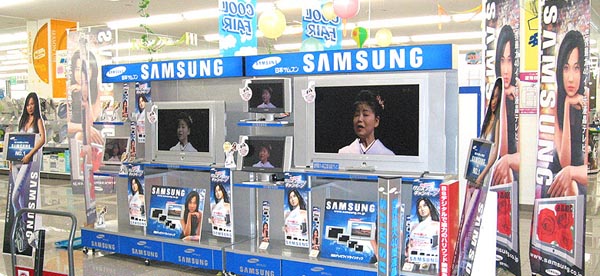Samsung eyeing Japan after 5-year hiatus

Samsung Electronics’ flat-screen TVs are displayed at a store in Japan in 2002. [JoongAng Ilbo]
Samsung Electronics, the world’s No. 1 manufacturer of flat-screen televisions, plans to sell liquid-crystal display (LCD) TVs again in Japan after exiting the market five years ago, according to media reports.
The news comes after the company announced last month that it has severed ties with Sony regarding the joint LCD venture the two previously set up called S-LCD.
Japan’s Nikkei daily reported yesterday that Samsung will start selling 40-inch or larger LCD TVs equipped with 3-D capabilities and Internet connectivity, as well as LED (light-emitting diode) TVs with power-saving features in the neighboring country from 2013.
Samsung ventured into the Japanese market in 2002 but failed to leave a strong impression there mostly due to its low brand recognition and Japanese consumers’ preference for local brands. It pulled out in 2007 at a time when it held an unimpressive 0.3 percent market share.
The Japanese daily said Samsung believes it should be able to enjoy a single-digit share if it rolls out the cutting-edge TVs ahead of its rivals, adding that it is already in talks with major retailers in the country.
A spokesman for Samsung Electronics’ TV business said nothing has been set in stone yet, yet rumors of its intention to give Japan a second shot began surfacing in September of last year.
On Dec. 26, Samsung announced its intention to buy Sony’s stake in S-LCD, a joint venture the two partners set up in 2004 to feed their respective LCD panel inventories. This effectively made their relationship less complicated by putting them back in the position of being just rivals.
Some market insiders in Japan saw this development as easing Samsung’s concerns about re-entering the Japanese market, in which its domestic rival LG is also currently performing well. LG restarted TV sales in the country in November 2010 and is building up a strong presence in the 3-D TV market there as well.

Nikkei drew attention to how the popularity of Samsung’s Galaxy smartphones, launched in Japan last year, contributed to the company’s improved image.
According to market researcher DisplaySearch, Samsung Electronics controlled 18.7 percent of the world’s flat-screen TV market in 2011, while LG Electronics owned 13.1 percent. Sony and Panasonic trailed with 10.3 percent and 7.9 percent, respectively.
Meanwhile, Samsung Electronics continued its bullish run on the stock market yesterday by breaking its previous record high with a closing price of 1.105 million won ($960) after exceeding the 1.1 million won mark in early trading.
Despite its status as a Kospi bellwether, Samsung Electronics’ latest streak far outstrips the performance of the benchmark index.
Since the company’s stock value hit a 52-week low of 672,000 won last Aug. 19, it has shot up 64.4 percent in five months. Over the same period, the Kospi has risen just 7.5 percent, from 1,745 points to 1,875 points.
Samsung Electronics’ market capitalization also vaulted past the 160 trillion won mark for the first time to rest at 162.8 trillion won yesterday.
Part of the reason its share value outpaced the rest of the market was because of its stellar earnings performance.
Sector analysts expect the company, which announces its fourth quarter earnings on Friday, will report around 5 trillion won in operating profits for the three-month period. They said its leading position in the smartphone market has provided the main momentum for such a curve-shattering performance.
The company “began reporting surprising earnings gains in the third quarter and tech stocks’ [strong] performance,” said Noh Geun-chang, a tech sector analyst at HMC Investment & Securities. “The company’s performance and stock value far outpaced the market’s expectations.”
The company’s winning streak is forecast to continue this year.
“Samsung Electronics will dominate the mobile device landscape, cementing a synergistic structure that not only includes smartphones but also semiconductors, AMOLED [active-matrix organic light-emitting diode] screens and other related products,” said Kim Young-chan, a sector analyst at Shinhan Investment.
As such, the market widely expects the Samsung subsidiary’s share price to keep on climbing. According to the forecasts of 25 securities brokerages, compiled by investment data provider FnGuide, the average target price for Samsung Electronics is 1.25 million won per share, about 13 percent above yesterday’s closing price.
With the Kospi failing to gain traction since August, and reliable stocks increasingly hard to come by, the dependability of Samsung Electronics’ latest climb has drawn a lot of big investment movers, such as major investment advisory companies, to boost holdings lately.
Although standing firm on Samsung Electronics’ fundamentals, analysts warn that the popularity of its stocks is a double-edged sword that could lead to a wave of sales by investors seeking quick returns.
By Kim Hyung-eun, Lee Jung-yoon [hkim@joongang.co.kr]










with the Korea JoongAng Daily
To write comments, please log in to one of the accounts.
Standards Board Policy (0/250자)